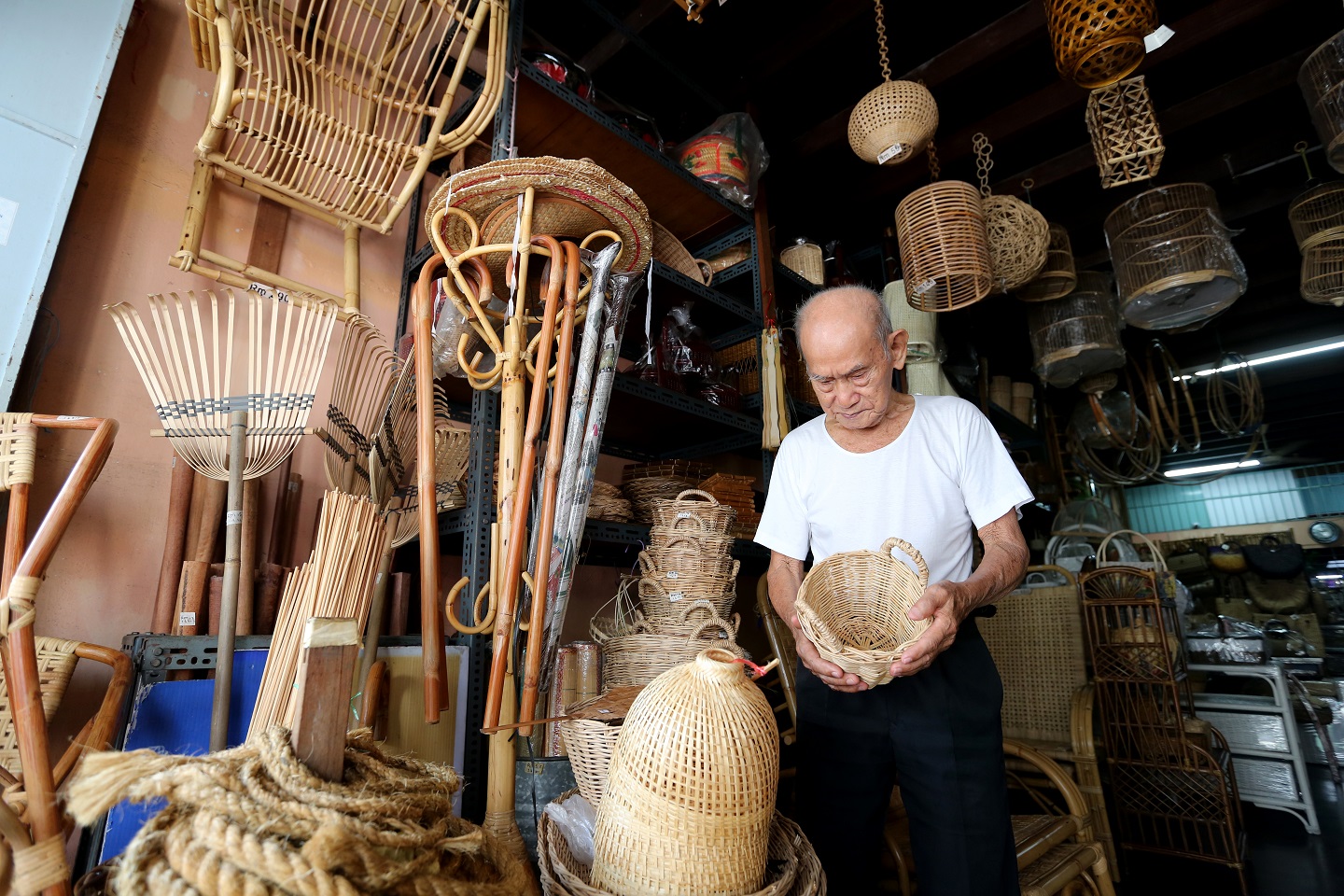
Rattan weaver, Sim Buck Teik (Photo: Sam Fong/The Edge)
On a muggy night in april last year, Narrow Marrow Café overflowed with attendees for Ryan Anderson’s long-awaited talk, The Death of George Town. Anderson, an ex-lobbyist turned film-maker based in Songkhla, Thailand, planned to unleash his thoughts on George Town’s development. The crowds congregating around buckets of Tiger beer were there to catch what Anderson had to say before he travelled south to finish his series of talks in Kuala Lumpur, Melaka, Johor and, finally, Singapore. They were also there to experience the relative novelty of listening to an intensely sincere Westerner like Anderson vocalise local angst over worrying signs of a city dying amid its gentrification.
“Is George Town losing its soul?” Anderson’s question has as much relevance now as it did a year ago. In his film documentary on this subject, Anderson was merciless in his portrayal of George Town’s gentrification, hijacked for investment opportunities by an unashamedly capitalist-driven state government and its many tentacles.
Anderson even presented a letter written by the Chief Minister’s Office explaining why it was imperative the chief minister spent over RM500,000 on a new Mercedes-Benz — paid for by state coffers — in order to apparently look the part when negotiating with big businesses.
Anderson’s point, however — irrelevant of the quirks that may ail any political office — was that the cost of a Penang state-sanctioned clean-up job preparing the city for a mass arrival of tourists, expatriates and multinational businesses had, regrettably, resulted in demolitions, evictions and a general feeling of the little person being stomped on by a grinning clique of rich, establishment types. Or, as one of George Town’s disgruntled lifetime inhabitants said in the documentary, “You are using me!”
Penang’s industry of traditional crafts — or the increasing lack of it — is just a fractal of Anderson’s vitriolic assessment of George Town’s mushrooming problem at large; of the city losing not only its soul but also the same unique aspects of culture and heritage the state has relied on so heavily in making it a “destination”. There are many ways to describe a process such as this, but words like “sustainable”, “longevity” and “rational” tend not to feature in these descriptions.
For over 200 years — from a period when the world had not yet invented the telephone, light bulb or braille — Penang has attracted craftsmen, and their expert skills, from China, India and Southeast Asia. As Datuk Koh Wee Khian noted in his historical summary of the Penang Art Society, “Display of works ... at public areas [is a] common cultural activit[y] regarded as an early form of exhibition.” Not only exhibited, craft filled a niche for things not yet taken up by mass production: shoes, joss sticks, baskets, signboards, stone masonry ... the list goes on. In every case, craft tradesfolk became defining aspects of George Town’s eclectic identity.
One of the tradesfolk I had originally planned to feature in this article was Yeoh Choon Seng, the last person to make fishing nets by hand in George Town. However, I am too late. After talking to the proprietors of HLF Fishing Supplies in Lebuh Pantai, I learn that he had already retired with no one to take his place. Apart from modifications to manufactured nets, there are no more handcrafted fishing nets made in the city.
George Town’s heritage trades have problems that are multifaceted and, sometimes, hard to predict. In general, however, they are as obvious as high-rises and Coca-Cola. Across the board, heritage trades are feeling the inevitable squeeze of gentrification, globalisation and world economics. The problems find their roots in the grand mechanics of a world at large and spiral down into the pinpoint realities of death and decay.
Hammered by weakening ringgit, inflation
As most of the trades were born at a time that relied on natural rather than synthetic materials, Malaysia’s weakening ringgit has presented the tradesfolk with a future horizon barren of potential profitability — of any future at all.
Joss stick maker Lee Beng Chuan takes pride in the fact that he imports his sandalwood from Australia. However, as I learn from his son, “Lee Jr”, a brace of middlemen and economic woes have meant an almost impossible profit margin. “You see, they always give the excuse, ‘Oh, you know Malaysian money goes down, now we have GST, so the cost goes up.’ But, we don’t increase our price by RM15 or RM20. No — we only increase RM1. We don’t want to take advantage of the customers, but an additional RM1 cannot make us rich,” he says.
Penang’s industry of traditional crafts — or the increasing lack of it — is just a fractal of Anderson’s vitriolic assessment of George Town’s mushrooming problem at large; of the city losing not only its soul but also the same unique aspects of culture and heritage the state has relied on so heavily in making it a “destination"
Other trades deal in resources infinitely more susceptible to dangerous fluctuations in world value. Lee Chee Cheng, who affectionately introduced himself as Bruce Lee, makes and engraves signboards from jelutong wood and gold leaf. After he carves the characters on the board by hand, gold leaf squares are placed over the engravings and smeared into them with a stiff brush — much like painting.
“[Inflation] has made the prices of materials go up very fast,” he says in his airless workspace, the fan switched off to stop the gold leaf from being blown away.
“Every year, we have to increase prices. Our gold leaf is imported from China, and exchange rates ... my cost used to be 30% of the final price of a signboard. Now, it is 50-50.”
He shows me a board around four feet by three feet in size. “Sometimes, the local wood is spoilt with holes and things like that. But to import from China is very costly,” he says.
Like Beng Chuan and his son in the joss stick trade, Bruce also highlights the struggle of handcrafted goods competing with their machine-made counterparts. “Even in China, they don’t go for hand-carved; they go for machine-made. If I were to carve this one, it would cost you about RM2,000. If you were to import from China, machine-carved, you could buy it for RM600 to RM700. If a person does this for money, he can’t survive. You cannot make big money,” says Bruce.
Yeoh Gim Huat the stonemason and Ng Chai Tiam, who makes “chop me” (traditional Chinese stamps), are also at the behest of rising prices from imported goods. They use stones imported from China for their quality, despite having to incur higher costs for them.
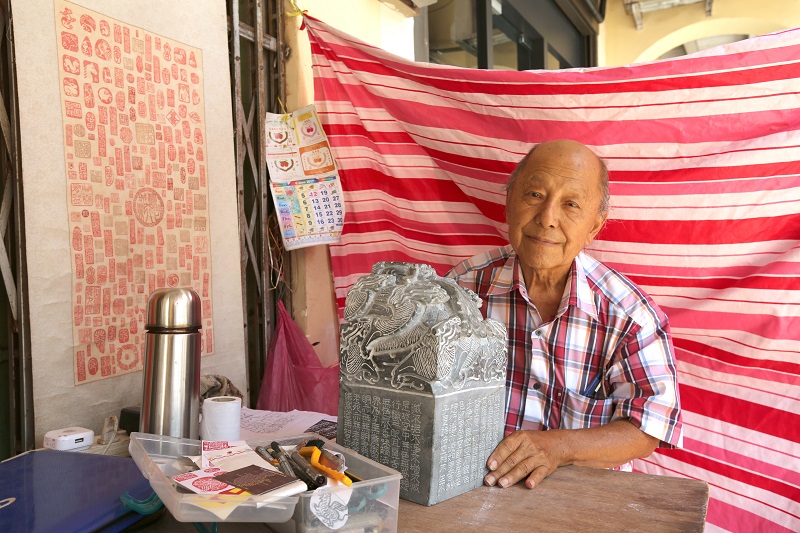
May Lim, George Town’s last Peranakan kasut manek beader, has felt the hammer of increased prices on quality materials. Her preferred thread of choice, which she used in her younger days and swears by even now, is DMC, a French thread valued for its strength. “When I started learning, a wheel of the thread cost me about RM3.50. Now, it’s over RM20. I can’t even get my needles from the UK; they are so precious, so now I use Japanese ones. Even those cost me RM3 a needle,” she says.
Haja Mohideen Mohamed Shariff, who operates from a sewing machine on the side of Keramat Nagore Dargha Sheriff Mosque in Lebuh Chulia making songkok, complains that the cost of his velvet imported from South Korea “increases every year”.
Another reason for Haja Mohideen’s declining profitability, however, also bleeds into a modernising culture as well as fiscal realities. “People are looking for cheap ones. People don’t wear songkok all the time like before. Now, they seldom wear them. Sometimes they don’t even wear one to the mosque. So, they buy the cheaper option,” he says.
In a situation like this, where not only tradesfolk have lower profit margins than machine competitors but also service a dwindling traditional market, the possibility of the trade dying completely is very real indeed.
And then, there is the problem of dwindling supply of raw materials used in their trades.
George Town’s famous rattan weaver Sim Buck Teik and his family are struggling to find the rattan crucial in their trade at a reasonable price because, put simply, it is running out. After generations of rattan weaving in Malaysia, the material is becoming increasingly difficult to harvest because the palm was not replanted after being cut down in the past.
To put this into perspective, the trade once boomed with China because rattan does not grow naturally there. In fact, as Sim’s daughter tells me, rattan baskets exported to China were actually deconstructed and sold piecemeal due the value of rattan, rather than the basket itself.
Paper effigy maker Loh Ah Ban uses a dwindling supply of kayu Batam to make the frames for his models, and even Bruce cannot find jelutong wood the right size to make bigger signboards, having instead to join two pieces together, therefore increasing labour and, eventually, cost.
Integrity aplenty, glory none
The knock-on effect of this issue of profitability leads to what could be called a lack of glamour to tradecrafts in George Town. Understandably, this has turned interest in tradecrafts into a veneer held together by those who would like to see the trades continue but would never take them on themselves as careers, or even vocations.
There is no place for tradecrafts in Malaysia’s modernising, consumerist society, it seems. In every instance, tradesfolk refer to their work as “hard”, “long” and “difficult”, not to mention devoid of money. Any bright, young Malaysian would be loath to take up a career that does not require snappy clothes, the latest technological accessories and a foot in the door to global markets through shares in a multinational employer.
Tradecrafts do not provide pension schemes, consistent pay cheques every month or any financial stability to speak of. In a modernising society where you can make money from the relative comfort of an air-conditioned office filled with co-workers and stable, mindless work, the very existence of tradecrafts is a sweaty, lonely and uncomfortable reminder of days better left behind. To Malaysia’s younger generation, who covet modern, Western markets as the exciting and expected future owed to them, tradecrafts resemble a sector lacking in fashion and trendiness, so far behind the front lines of modernisation and globalisation that any future success will inevitably come without glory or recognition.
How do you convince a fresh graduate to spend a life dedicated to a heritage craft when his or her future status in society is destined to end in obscurity?
Last year in the UK, Hector Cole and Lisa Hammond joined the growing list of craftspeople honoured by the Crown for services in their field — Cole for his expertise in making historic arrowheads by using ancient blacksmith techniques, and Hammond for pottery and ceramics. These are just two examples, but they show that the state has an important role to play in promoting tradecrafts and making it more attractive to the youth.
In George Town’s case, the trades come with little state or federal recognition. Of all the tradesfolk I interview, only Sim has anything to show for his lifetime of effort — a faux-gold plaque on a wooden board given by the Penang Heritage Trust, “in recognition of invaluable contributions to the intangible cultural heritage of Penang”. The others have either not received any awards or do not think it is important to show me.
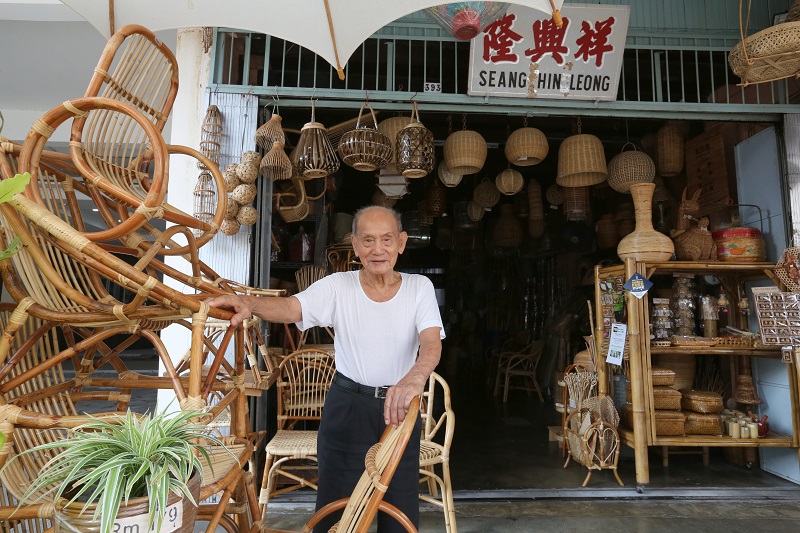
While on the surface Sim’s award seems like a sincere act of gratitude, it very quickly becomes as “intangible” as Penang’s cultural heritage when compared with Malaysia’s current list of federal honour awards available. Anything — whether it be a trade, business, sport or belief — is under threat when the younger generation cannot find in it idols worthy of emulating. It will remain as impotent and unappetising as food without flavour. As Bruce told me, “You must have status; only then will people go for it. But we don’t have. The honours only go to big businessmen. I feel we have sacrificed ourselves.”
Not about making profit
And yet, the root causes of Penang’s heritage trades dying out are as much internal as they are external. In the same way that the work itself does not conform to the style of modern society, the thinking behind the trades — by the tradesfolk themselves — often has little bearing on what modern society would consider right and true. George Town’s tradesfolk are mentally and physically built for patience, mastery and principles — very different to current obsessions with speed, instant gratification and fickle, ever-changing thoughts and allegiances.
For instance, Beng Chuan makes his joss sticks by hand every single day, using a process unchanged since having learnt it on leaving school after World War II. He starts by kneading the ingredients into a dough, which is then pulled over bamboo sticks or shaped into conical mounds that look like witch hats.
After smoothing them out, he dries the joss sticks in the sun for two days. It is a simple yet time-consuming process, but one that he will never change. “My dad works 365 days a year. Even on Chinese New Year, he works. It involves a lot of work,” explains Lee Jr.
He describes his father’s work as an “obsession” numerous times, work that drew most of its existence from love of craft over anything else. “A lot of people say, ‘Oh, when it comes to the mixture, why don’t you get a machine’, like making a cake,” he says. “But, don’t overlook that the machine does not have senses. When we mix the powder, we need to do it hands-on so we have the feel for proper distribution of ingredients. To make it equal, you see.”
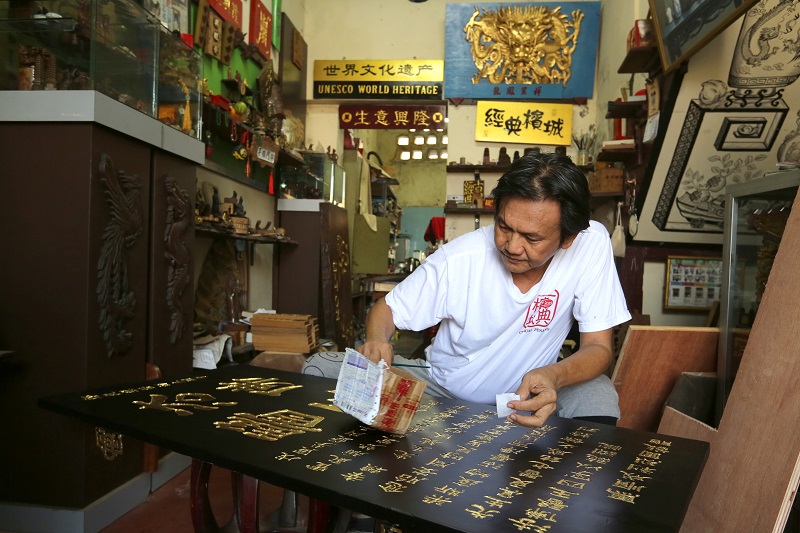
Despite his efforts, however, Beng Chuan — like other tradesfolk — maintains that he does not do his work for profit. “His mind is not thinking of making a profit,” says Lee Jr.
Where the addition of a machine, chemicals or even sales could offset the issue of lack of profit, Beng Chuan sees these ideas as impossibilities rather than considerations. “You see all these dragons,” says Lee Jr, pointing to three display cases holding ornately painted Chinese dragons. “These are all handmade by my dad. There was a Singaporean who offered RM5,000 for one of them. But my dad said no. Should we stop this trade, we will take all these dragons and give it to our Penang State Museum. There is even a person from Kuala Lumpur who invited us to do a demonstration and was willing to pay. But, as long as we are comfortable and can cover expenses, we are quite happy.”
Even May, probably one of the more active traders in George Town having travelled to Paris to promote shoe beading, holds true to the notion that she plies her trade for something other than money. Despite sharing her own story of a Singaporean asking to buy one of her products — a shoe beading design that took her three months to complete — her fundamental conclusion was that, “My objective is not to make money. I don’t want it as a business. What do I need money for? I mean, I’m not rich but, as long as I’m healthy, I am happy.”
May, however, takes it even further than a question of making money. For her, part of the problem is the added stress that she would incur in keeping the trade alive. “I am one person who doesn’t like the limelight. Until today, the chief minister does not know that I went to Paris. I know the governor and wife personally, but they don’t know I do shoe beading. They only know me as the vice-president of the Senior Club,” she says with a chuckle.

Her current agreement with the Penang Heritage Trust is that “anything to do with administration or anything of the sort ... I will not deal with it. Don’t expect me to attend meetings; I hate meetings. They send me students and I teach — that is all”.
The Penang Heritage Trust has also helped Beng Chuan by designing a simple pamphlet to give out to tourists, but Lee Jr complains that trying to expand the business is a stressful prospect. He has grand plans on how to reach the public — banners, business cards and other things that any modern entrepreneur would have made his first port of call — but in his own words: “We have all these local newspaper cuttings that we laminate and I hang up there. They may fly away. Previously, we had a guy who made two boxes of calling cards for my dad but we don’t know where he went. After, I went to the printer to do it again and they said I need a soft copy; I am not an IT guy. Even the leaflets we cannot reprint. It is a bit stressful.”
So instead of turning tradecrafts into viable and attractive businesses capable of drawing young, enthusiastic and energetic men and women into the fold, tradesfolk are at a loss as to not only how to do it but also why. After a lifetime of perfecting a trade and living the life required of it, they are wondering whether allowing their life’s work to be swept up by capitalism is right or even fair.
Caught in a stalemate
By far the most self-destructive issue behind Penang’s dying trades is the worrying impression that the tradesfolk do not want to pass the trade along at all, or at least not in its entirety. I have heard this idea before from previous researchers, but only until speaking with May does it become real. “This is more a typical Chinese character. When they teach, they don’t pass on 100% to you; they keep 20%. There are some people that do not teach at all, because of a ‘this is mine’ mentality. By nature, selfish,” she says.
It may sound like a damning and unbelievable proclamation, but Lee Jr sheds some light on its legitimacy. “My dad does teach people but we don’t teach people completely. If you are a willing student, he will teach you provided that when you have mastered the thing it does not affect our business. We are not afraid of people knowing our trade; we are very open-minded people. Our phobia is of competition,” he says.
This sort of mentality would have Ayn Rand turning in her grave, appalled at the complete lack of capitalist egotism.
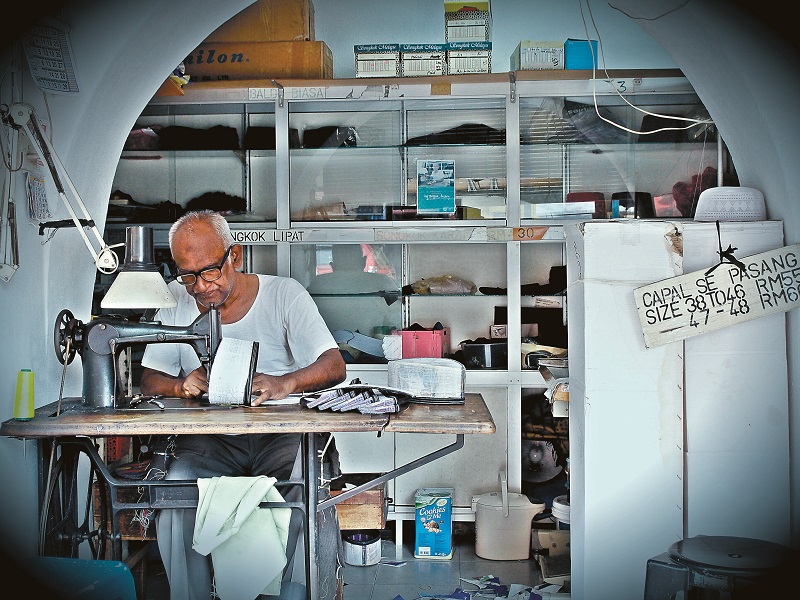
These problems reveal a way to look at heritage trades in George Town. The trades are caught in a stalemate with modern Malaysia by being unable to progress because of economic realities that will not change for them, and which will arguably get worse. They are protected by a demographic that has become used to a life with little money, technology and worldliness, and who do not need more. The trades themselves are hard modes of living and do not come with any recognition to make them attractive. On the other hand, the trades cannot die out; Penang has too much riding on their heritage value to propel it into the future and retain its Unesco listing.
In this way, they are completely heritage concepts and cannot fall under the guise of sustainable businesses. What, then, can protect them sustainably, respectfully and with dignity?
The benefits of heritage trades to George Town extend beyond cultural bait for potential tourists. There are numerous leaflets to be had explaining where they are and what they do — the most informative one is printed by George Town World Heritage Incorporated, which lists 30 trades operating in the city, in its booklet Heritage Traders of George Town. From this perspective, the trades are integral to George Town and Penang as conduits for leaflets, booklets, maps, walking routes, tours and all the other things idle holidaymakers require. In a word, they are great publicity for tourism in the state.
Yet, when treated as conduits for quality products, the trades take on a meaning far more important than being an “intangible cultural heritage of Penang”. For those who dream of a life gone by, of a time when products did not come with built-in expiry dates but were made to be the best they could be, heritage trades still fill that niche.
Due to strict business morals, tradesfolk make products that last, have not cut corners and are made from the atavistic ideal of quality rather than profit — traditions that are simultaneously contributing to their death but also hold, I think, the key to their future.
Where originality is a requirement
Loh, the paper effigy maker hidden away on Lebuh Carnarvon, works in an industry that will never die. His effigies, ranging from houses to table fans, are made to honour the dead, used in funerals and festivals as offerings burnt for the deceased. Still, he and his son-in-law learning the trade believe in using the best products they can to serve their customers.
“You see this colour,” Loh’s son-in-law says while pointing to a pre-made mansion, “this one is printed just for us. It glows in the dark, so it is more expensive. Other places use normal colours only.”
The unforgettable Beng Chuan makes his joss sticks entirely from natural products and screws his face at the suggestion of adding chemicals or “yellow powder” to compromise his creations. His joss sticks are a mixture of Australian sandalwood, Tibetan holy grass and incense.
In a modernising society where you can make money from the relative comfort of an air-conditioned office filled with co-workers and stable, mindless work, the very existence of tradecrafts is a sweaty, lonely and uncomfortable reminder of days better left behind
“Our sandalwood can act like therapy,” says Lee Jr. “We had feedback from a Scottish lady who complained of insomnia. After burning a few, she said she slept like a baby!” This would have sounded like a tall tale to me were I not holding the very postcard on which that feedback was conveyed.
“Our Tibetan holy grass can eradicate negativity,” Lee Jr says confidently. What’s more, Beng Chuan’s joss sticks have a unique selling point as with a masterful stroke of his hand, he adds calligraphy to each joss stick that is big enough to contain it.
When it comes to the carvers — Yeoh, Bruce and Ng — the handmade quality comes through as something exclusive. These trades guarantee originality in industries where being unique is not only preferred but also required: a headstone, signboard or company stamp can and should not be replicated in any way, for reasons of basic integrity.
For Ng, the detail in the figures carved at the top of the stamps that act as handles is masterful, time-consuming work completed with great concentration under a magnifying glass. He is also excited to show me his personal paintings hanging on the walls of his cluttered shop. He studied Fine Art in Hong Kong and seems to have refined his skill with a brush as well as a chisel. His shop is messy because he has just relocated from his previous residence — next to Bruce’s — due to higher rent.
Lastly, there is May, whose skill reflects best the heritage behind all trades in George Town. A third-generation Peranakan by birth, May has retained, above all things, an eagle eye when it comes to threading a needle or bead, a talent she describes as “God’s gift”.
May learnt beading from her grandmother, along with other female members of her family in her kampung home. Much like other tradesfolk, she started young — around 10 or 12 years old, threading needles and choosing beads for her grandmother — which translates into over 60 years of experience in beading.
“My mother was very traditional,” she says. “All us girls must learn how to cook. We had to knit, we had to crochêt, we had to tat.” And the quality of her work begins from the European beads she uses all the way to the final shoe or handbag.
“You see this stitching,” says May, showing me the reverse side of a shoe design. “There is no knotting. I don’t use knotting; it makes it very messy at the back.”
I am amazed to see a clean back with none of the messy criss-cross threading typical in woven products. When a beaded design is finally ready for a shoemaker, May goes to the famous Wong Sam Chai, mentor to Datuk Jimmy Choo. May believes that shoe and bag makers who use her beading techniques will produce something that “can last a lifetime”.
How to save the heritage trades of George Town
Considering these examples of heritage trades, buying from the tradesfolk, as opposed to manufacturers, will not only furnish the customer with a quality product but could also be the best way to bring heritage trades back into a fast-paced and growing economy.
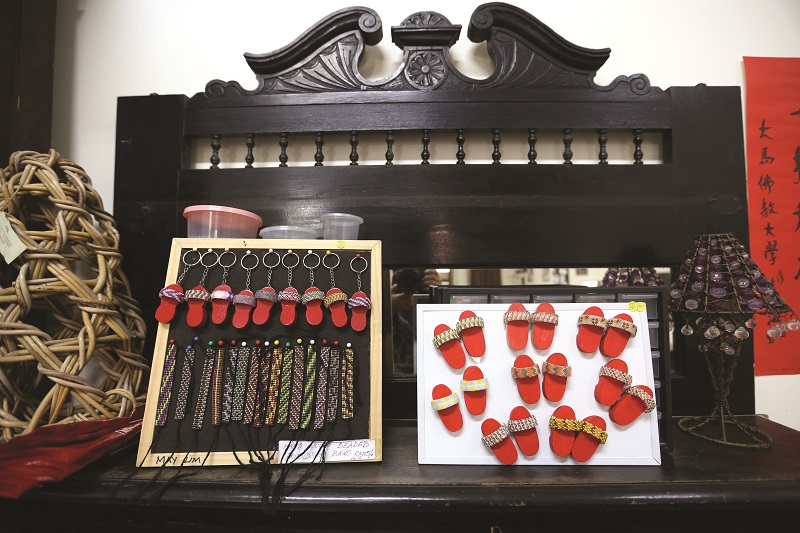
Help from the state government and heritage organisations in George Town exists but in a fickle and symptomatic way. Sim’s family of rattan weavers reiterate what I learn from nearly all the traders: “Sometimes, they (heritage organisations) give RM2,000 a year — only sometimes. Our state government gives some money to people. But not all the years. For us, they only give one time. Sometimes, we wait for big companies to sponsor us,” says Sim’s daughter as she stands in front of the award plaque.
When I ask why they do not receive a regular stipend, her answer was to the point: “Lim Guan Eng also no money! Federal government got money but not in Penang.”
It must be a perplexing reality to live on an island actually growing with land reclamations yet unable to furnish a heritage icon with a regular subsidy to make ends meet.
Talk of an initiative that spread over the heritage trade grapevine was the plan to relocate all the tradesfolk to Kimberly Street in George Town, lumping them all together in a neat package for the tourist crowd. Presumably, this would come with subsidised rents but little else, except a push to turn George Town into a heritage zoo, each aspect of culture grouped together in separate enclosures. Without a doubt, this initiative is paved with good intentions. But one only need look at heritage sites around the world to notice the real effect of this type of thinking — high streets lined with shops selling tourist bric-a-brac, traditional trades presented as if on stage and a feeling of being so removed from reality that the essence of a site dissipates completely. In fact, Armenian Street reflects this dilution of culture worryingly close to home.
What is, then, the best way to save the heritage trades of George Town?
Despite their time-consuming work, the tradesfolk are all imparting the knowledge of their trade to the younger generations, irrespective of what they hold back. Whether by keeping the trade knowledge in the family — like with Lee Jr taking up the joss stick trade or Loh’s son-in-law continuing the paper effigy business — or running a constant series of successful courses — as with May or even songkok-making classes on the mainland — the knowledge is being shared with many.
The problem is how unattractive the trades are themselves. These are not viable businesses anymore, merely nostalgic baubles to exist as fantasies from a bygone era. In order to change that perspective, they need to have buying power behind them. If they are to remain local entities, then the population of George Town, the state, or even the country, need to support them by buying and using the products, not just out of principle but also as a sincere appreciation of what heritage trade products have to offer.
The result would be a backlog of orders, a profit-by-volume income and a resurgence of public value in heritage products. Couple this with federal and state recognition of the tradesfolk, to recognise what their livelihoods do for not only the state but the country as well, and suddenly the trades become a viable proposition to young adults thinking of dedicating their lives to a purpose.
Make no mistake, the heritage trades of George Town are under threat of extinction; if not wiped from society completely, then set to lead an unnatural existence, monitored by umbrella institutions and charged each day with putting on a show for people to “ooh” and “ah” over their unique “nature”.
To keep them in their complete form, as not only cultural inspirations but also normal parts of George Town’s city machinery that runs deep with heritage, they need to be treated as such — normal. They started as businesses and should continue as such, used by consumers for quality and taken on by new practitioners as lifelong pursuits, continued with an ideal voiced in 1897 by Joseph Conrad: “Art is long and life is short, and success is very far off.”
This article first appeared in By George by The Edge, 2017. James Springer is a contributor.


